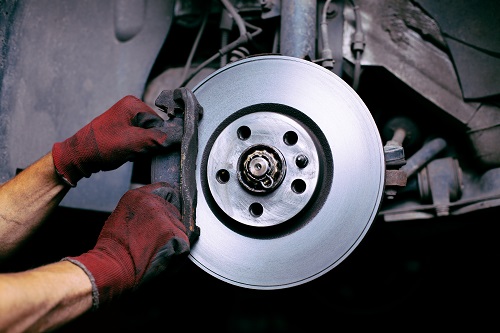
Why are my brakes squealing? The brake pads will scrape off surface rust from the rotors the first time you use the brake pedal. The squealing or squeaking noise could be caused by dirt and moisture that accumulates on your rotors. This can also happen when you apply the brakes for the first time after waking up in the morning, especially if it has been raining. No worries if the brake noise goes away after several brake applications.
Problems With Brakes
The brakes will cost more if the noise is constant or occurs every time you brake, or if you hear the squeals while driving.
When you hear a high-pitched, continuous squeal as you drive, it is likely a wear indicator that will alert you to the need for new brake pads. A small metal tab will come in contact with the rotor’s surface as the pads thin out. This is similar to a needle on vinyl records. Some wear indicators appear differently, and may only be noticeable when your vehicle’s brakes are applied.
For other squeals or squeaks, you will need to have your brakes inspected. You may also require lubrication, adjustment, cleaning and/or new parts. The most common cause of brake noises is worn or loose components.
A rotor that is unevenly worn (often called “warped”) will not allow the brake pads to press flat against it. This can cause vibrations and noise. Unevenly worn brake pads will not press firmly against the rotor, and they may even chirp. The brake pads may be loosely attached, or the shims holding them in place are corroded.
There are also the brake pads themselves. Some mechanics warn that bargain-bin brakes pads will be noisier than more expensive, higher-quality pads. In addition to loose or stuck calipers, noise can be caused by them.
As there are many possible causes of brake noise, and as brakes are an important safety feature, it is best to let a professional inspect and diagnose the brake noise in your vehicle. Bring your vehicle to an auto repair shop immediately.
Grinding noises are usually caused by brake pads that have worn out and the backing plates they were mounted on being squeezed up against the rotors. Metal-to-metal contacts mean that the rotors will also need to be replaced. You probably ignored earlier warning signs.
 How do I know if my headlights are aimed correctly?
How do I know if my headlights are aimed correctly?
You may be unaware that your car’s headlights are not properly adjusted. How can you be sure? How can you tell? Oncoming drivers may flash their lights in your direction because they are blinded by your headlights, even if your high beams are not on. Or, the road is only brightly lit for 20 feet, indicating that the headlamps have been aimed too low.
A suspension problem or a heavy load of cargo can cause your vehicle to ride higher or lower, and move one or both lights subtly. The impact of a collision or a road hazard can also cause a light assembly to move and misalign.
To check if your headlights are aimed correctly, park the car on a flat surface and shine them on a wall or garage door 25 feet away (other cars may need a different distance). For most vehicles, the top of the low-beam shining on the wall must be just below or at the same height as the center of your headlight lens. The pattern of light should be higher on your right (passenger) side in order to illuminate road signs, and lower on your driver’s side so as not to blind other drivers. You should be able to tell if the beams are correctly aimed at both sides.
Use masking tape and mark the vertical and the horizontal center of the light beams. The vehicle should be moved 25 feet back. The light beams can be adjusted to the same height both vertically and horizontally using the tape line.
How to adjust headlights
Some vehicles have an adjustment bolt or screw on the headlight assembly to adjust headlight height. Others have a screw that allows for horizontal aim. Some vehicles have a bubble level to assist with adjustments.
Some vehicles have very little space for adjusters, and you may need to remove parts like the battery. To get an accurate reading the vehicle must be level, with no flat tires, damaged suspension parts or cargo in the way. It should also be perpendicular to the surface you are shining your headlights on.
Most vehicle owners’ manuals provide little or no information on how to aim the headlights. If you are unsure, have a repair shop check it. A certified auto mechanic can check and align the headlights for free if the vehicle is still under warranty.
Call Miller Brothers Transmission Auto Repair and Body Shop now if you need the help of an expert auto mechanic to check your car’s brakes and headlights.
Like our Facebook page for more great info about auto services.
Miller Brothers Transmission Auto Repair and Body Shop
7123 Tazewell Pike
Corryton, TN 37721
(865) 689-5072
https://www.millerbrosautorepair.com/
Serving Knoxville, TN and Knox County
Service areas include: All of Knox County, Corryton, Fountain City, Halls Crossroads, Powell and Knoxville

No comments:
Post a Comment